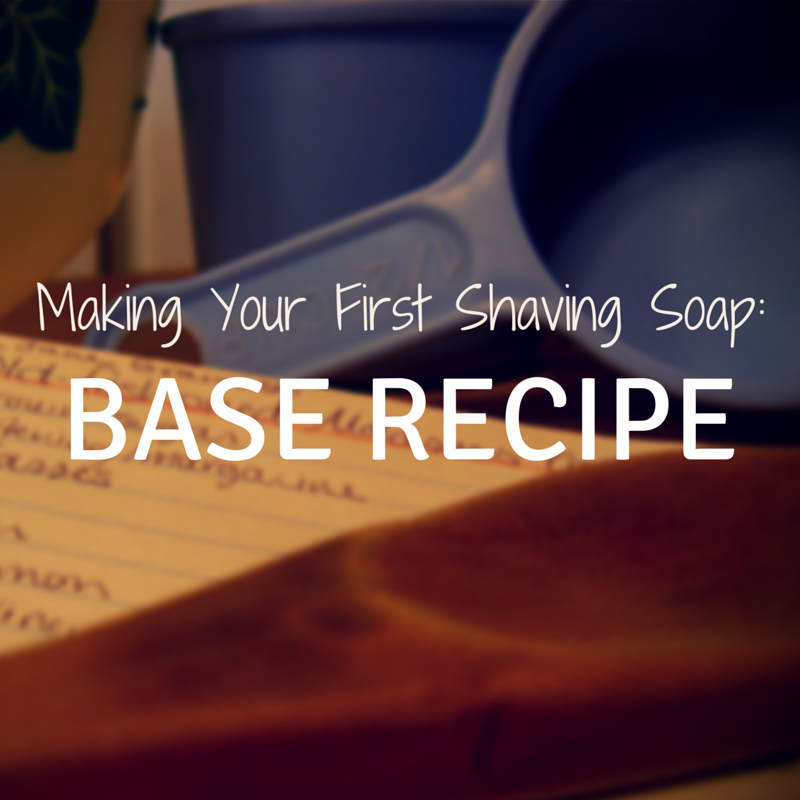Looking for a shaving soap recipe? I’m going to show you how to make your own, even if you’ve never made soap before.
If you’re new to soap making, it’s still a good idea to start with a base recipe to work from. That way, you can make small adjustments and observe their results.
I told you, making shaving soap is both an art and a science. And the best way to go about science is to build on the results of others and manipulate one thing at a time.
For that reason we’ll start with a very basic (but tested) shaving soap recipe from the Badger & Blade forums courtesy of JBLA, then look at some modifications you might wish to try.
The Basic Recipe
Keep in mind all ingredients are measured by weight in soap making, even water.
For 1lb shave soap:
- 8.33 oz Stearic acid
- 7.66 oz Coconut oil
- 8 oz Water
- 3.5 oz Potassium hydroxide (KOH)
- 1 tbsp Glycerin
(Included in the above are Amazon links for each ingredient. You might be able to find them locally, but Amazon is usually cheaper and more convenient. Most of them aren’t on the Canadian site, and I’m a bit jealous…)
This recipe works well enough for a starting point. If you want to try something else, though, we’ll discuss a few possible modifications later.
Method
Go read up on the method for making hot process soap if you’re not sure what it involves.
Briefly, you are going to:
- Melt the oils in your crockpot (stearic acid and coconut oil are solid at room temperature).
- Don your stylin’ safety gear (safety glasses, long sleeves and gloves).
- Add the lye to the water (NOT the water to the lye) in a high-temperature plastic vessel like a measuring jug.
- Stir the lye with a plastic or silicone spatula (don’t use any metal utensils – they may react with the lye).
- Add the lye solution to your oils.
- Stir the soap. Try not to panic as it reaches instantaneous trace – it’s a side effect of using isolated stearic acid. Don’t worry, you haven’t done anything wrong!
- Cook the soap on low for about 60 minutes.
- Test the soap using your tongue (the ‘zap test’) or, if you’re not into minor chemical burns, use a pH indicator strip (but be aware that these indicators may not be 100% accurate).
- If the soap passes your pH test, use your spatula to transfer it to your mold of choice. Popular molds for shaving soap are pringles cans, mugs/bowls, and scrap pieces of lined PVC pipe with one end sealed.
- In a few days (or whenever your soap has cooled and set), slice your first homemade shaving soap and go shave!
Modifications
Join me in the next post for some examples of modifications we can make to this recipe: a simple fragrance, a minor tweak to the oils, and choosing a superfat. I’ll also introduce you to an invaluable online resource for soap making!
I can’t wait to give you a range of modifications sure to give you a unique and enjoyable soap and ignite your passion for making soap! Hopefully, this post already has your mind working out different twists you could put on this basic shaving soap recipe to make it your own.
——————————
Thanks for reading this post at ShaverSoaper! I want to hear your questions and comments on making shaving soap, so please leave them below! What do you think of the new site? Don’t forget to sign up for the email newsletter to get updated on new posts, and please share this post if you know someone who’d enjoy it. You can also catch up with me on Twitter or Facebook!
See you next time!
Lewis


I tried this recipe from BnB and was impressed with it. I’m looking forward to seeing what modifications you try.
you could try a NaOH KoH mix, this should leave you with a softer puck